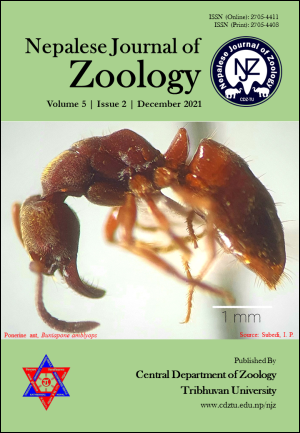Activity pattern and habitat association of Assamese macaques Macaca assamensis McClelland, 1840 in Shivapuri Nagarjun National Park, Nepal
DOI:
https://doi.org/10.3126/njz.v5i2.42032Keywords:
Ad libitum sampling, Diurnal activity, Habitat association, Instantaneous sampling, NagarjunAbstract
Assamese macaque Macaca assamensis McClelland, 1840 is one of the primate species with narrow distribution range and the least exploration. This study investigated the diurnal activity of Assamese macaque and association with the vegetation in Nagarjun Forest of Shivapuri Nagarjun National Park, Nepal. Behaviour sampling including Instantaneous sampling and Ad-libitum sampling (7:30 AM – 4:30 PM) along with vegetation survey (20 m × 20 m plots) were applied. The Raniban Barrack troop of Assamese macaque composed of 12 individuals was observed for a total of 225 hours to record the macaque’s diurnal activity. The troop spent 28% time in inactive, 25% in grooming, 23% in foraging, 23% in locomotion and 1% in fighting. Assamese macaque troop spent more time in Schima wallichii possessing 25.91%, 36.29% and 41.22% for foraging, locomotion and inactive respectively of the diurnal time. Altogether, 67 plant species (herbs, shrubs, trees and climbers) were documented from vegetation analysis. Schima wallichii and Ardisia macrocarpa were dominated the habitat. Paired t-test revealed significant difference in foraging (df = 24, P = 0.010) and inactive (df = 24, P = 0.003) between the morning and day observational phases. The findings of this study shed light on the food preference and microhabitat use by the protected Assamese macaque in Nepal that assists to formulate the management plans for the species.
Downloads
Downloads
Published
How to Cite
Issue
Section
License
Copyright (c) 2021 Kalpana Ghimire, Mukesh Kumar Chalise

This work is licensed under a Creative Commons Attribution-NonCommercial 4.0 International License.
This license enables reusers to distribute, remix, adapt, and build upon the material in any medium or format for noncommercial purposes only, and only so long as attribution is given to the creator.

